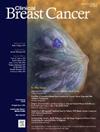Impacts of Tumor Stage at Diagnosis and Adjuvant Therapy on Long-Term Survival Outcomes in Patients With Triple-Negative Breast Cancer Achieving Pathologic Complete Response After Neoadjuvant Chemotherapy
IF 2.9
3区 医学
Q2 ONCOLOGY
引用次数: 0
Abstract
Background
It remains unknown whether the tumor stage at initial diagnosis and adjuvant treatments had any impacts on the long-term survival outcomes of patients with triple-negative breast cancer (TNBC) achieving pathologic complete response (pCR) following neoadjuvant chemotherapy (NACT).
Methods
Clinical stage II-III patients with TNBC who achieved pCR after NACT were identified from the Surveillance, Epidemiology, and End Results (SEER) program (SEER cohort) and the National Clinical Research Center for Cancer (Tianjin) in China (TMUCIH cohort). Survival analyses were conducted based on tumor stages and the types of adjuvant treatment received by the patients. The outcomes of interest were overall survival (OS) and breast cancer-specific survival (BCSS).
Results
The TMUCIH cohort comprised 178 patients with a median follow-up of 55.5 months. Two and 3 patients experienced BCSS and OS events, respectively. The SEER cohort included 1218 patients with a median follow-up of 65.5 months, where 53 and 78 patients experienced BCSS and OS events, respectively. Patients diagnosed with stage III disease had significantly higher hazards of death compared to stage II disease (OS: hazard ratio [HR], 3.34; 95% confidence interval [CI], 1.84-6.07; P < .001; BCSS: HR, 2.86; 95% CI, 1.38-5.92; P < .001). Adjuvant systemic and radiation therapy did not confer additional benefits to OS and BCSS.
Conclusion
Tumor stage at initial diagnosis remains an independent predictor of long-term survival outcomes in patients with TNBC achieving pCR after NACT. Postoperative adjuvant chemotherapy and radiation therapy do not appear to provide additional benefit to their long-term prognosis.
诊断时的肿瘤分期和辅助治疗对新辅助化疗后获得病理完全反应的三阴性乳腺癌患者长期生存结果的影响
对于新辅助化疗(NACT)后获得病理完全反应(pCR)的三阴性乳腺癌(TNBC)患者的长期生存结果,初诊时的肿瘤分期和辅助治疗是否有影响,目前仍是未知数。临床II-III期TNBC患者在接受新辅助化疗(NACT)后获得了pCR,这些患者是从监测、流行病学和最终结果(SEER)项目(SEER队列)和中国国家癌症临床研究中心(天津)(TMUCIH队列)中筛选出来的。根据肿瘤分期和患者接受的辅助治疗类型进行了生存期分析。研究结果包括总生存期(OS)和乳腺癌特异性生存期(BCSS)。TMUCIH队列由178名患者组成,中位随访时间为55.5个月。分别有2名和3名患者发生了BCSS和OS事件。SEER队列包括1218名患者,中位随访时间为65.5个月,分别有53名和78名患者发生BCSS和OS事件。与 II 期疾病相比,诊断为 III 期疾病的患者死亡风险明显更高(OS:危险比 [HR],3.34;95% 置信区间 [CI],1.84-6.07;< .001;BCSS:HR,2.86;95% 置信区间,1.38-5.92;< .001)。辅助性全身治疗和放射治疗并未给OS和BCSS带来额外的益处。初诊时的肿瘤分期仍是预测NACT后获得pCR的TNBC患者长期生存结果的独立指标。术后辅助化疗和放疗似乎并不能为患者的长期预后带来额外的益处。
本文章由计算机程序翻译,如有差异,请以英文原文为准。
求助全文
约1分钟内获得全文
求助全文
来源期刊

Clinical breast cancer
医学-肿瘤学
CiteScore
5.40
自引率
3.20%
发文量
174
审稿时长
48 days
期刊介绍:
Clinical Breast Cancer is a peer-reviewed bimonthly journal that publishes original articles describing various aspects of clinical and translational research of breast cancer. Clinical Breast Cancer is devoted to articles on detection, diagnosis, prevention, and treatment of breast cancer. The main emphasis is on recent scientific developments in all areas related to breast cancer. Specific areas of interest include clinical research reports from various therapeutic modalities, cancer genetics, drug sensitivity and resistance, novel imaging, tumor genomics, biomarkers, and chemoprevention strategies.
 求助内容:
求助内容: 应助结果提醒方式:
应助结果提醒方式:


